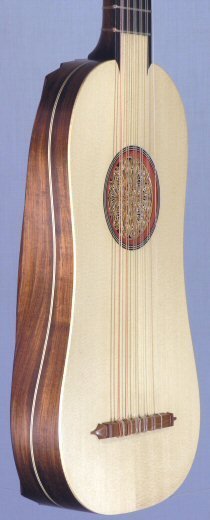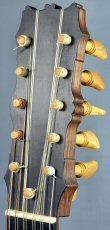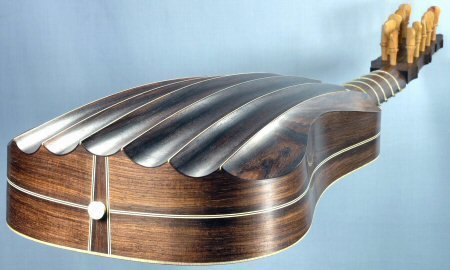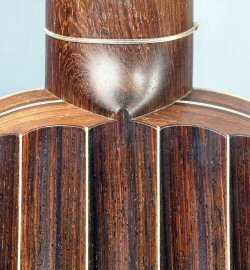Vihuela in G (SL 56cm) with cocobolo back ribs, solid kingwood neck.
This vihuela features similar body parameters to the original Dias vihuela, including a solid hard-wood neck (in this case made of Madagascar king wood, instead of ebony, as in the original) and cocobolo fluted back ribs. The choice of the solid ebony neck by the maker of the original Dias vihuela could well be a deliberate attempt (or indeed one of the features of the late 16th century vihuela making tradition) to achieve particular sound qualities of the instrument. It does seem that the use of the rather denser variety of wood here adds not only more sustain to the sound but also makes the instrument quicker to respond. In fact, a combination of such factors as the rather high value of the ratio of the string length to body volume and the use of dense varieties of wood for the fluted back, sides and neck is what makes the sound of the Dias vihuela model so unique. The most striking comparison here is with the the Portuguese c.1590 five-course guitar* which may well be made either Belchior Dias himself or another maker who was closely associated with the guild of Portuguese violeros of the time. These two instruments that are chronologically so close (in fact, they may even have been manufactured in the same year … and even the same maker!) – the Belchior Dias 1581 vihuela and the c.1590 guitar are, at the same time, so different in their construction and acoustics. The latter is virtually identical to the flat-back model of the guitar of the 17th century, La Guitarra Spagnuola, on which rasgueado music of early 17th century Italian publications in the alphabet tablature was supposed to be played. * * * All glue joints are reinforced with linen tape from the inside of the body (as found in the original Dias vihuela). The use of "cloth" for reinforcement of glue joints also seems to have been implied by the Lisbon Regimiento dos Violeros of 1572. * This guitar formerly belonged to Robert Spencer; now in possession of Frank Koonce, USA. The value of the ratio of the string length to body volume of this instrument is almost two times lower than that of the Dias vihuela. |
 |
 |
 |
 |
 |
For larger images click on the corresponding views below
home vihuelas guitars viols contact







